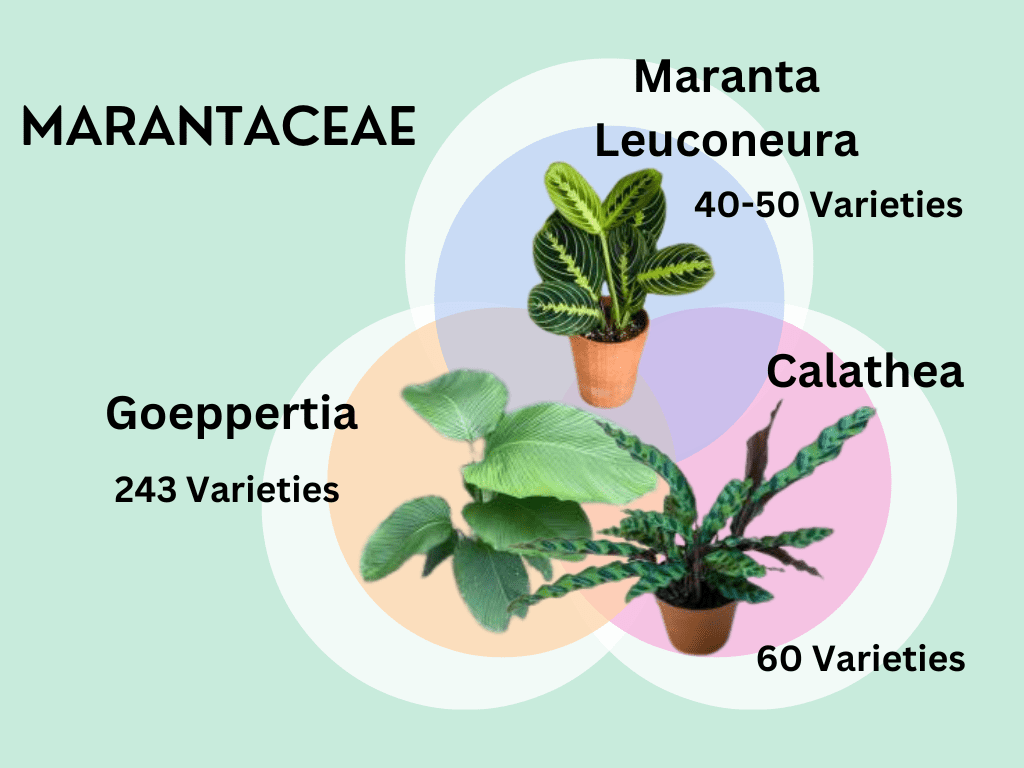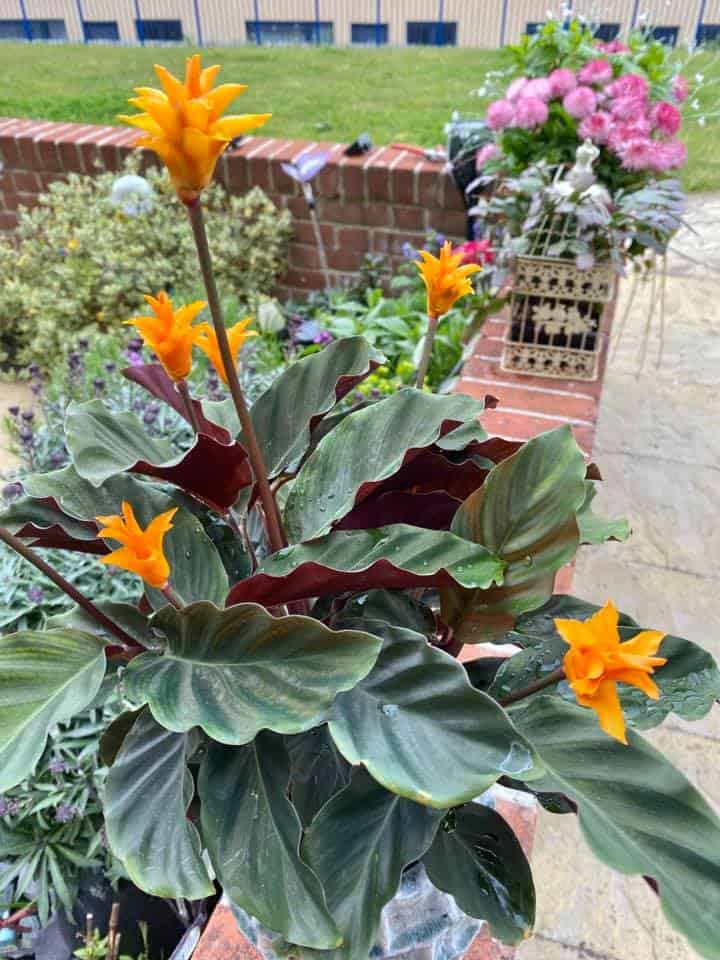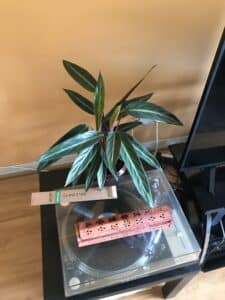Given its tendency to fold its leaves in the evening, it is named the Prayer Plant, resembling hands folded during prayer.
Prayer Plants also serve the lucky charm, and Feng Shui is a popular example in Chinese culture.
So, be ready to take on a journey to the beautiful world of Prayer Plants.
Table of Contents Show
10+ Prayer Plant Varieties (with Names & Pictures)
Named after the Italian botanist Bartolomeo Maranta, the Maranta genus is the most common name when a Prayer Plant comes up.

Below are some of the most sought-after types of Prayer Plants you might like.
1. Maranta Leuconeura ‘Kim’
Maranta leuconeura ‘Kim’ is a plant native to Brazilian rainforests which requires a minimum temperature of 15 °C (59 °F) to grow.
You can recognize this plant by the purple spots on the leaves.
It has light green foliage with creamy white streaks in its leaves.
These plants flourish as annuals and are suitable for growing in hanging baskets or decorative pots.
2. Maranta Leuconeura ‘Kerchoveana’
This is by far the most common species of the Maranta genus and is readily available. Most people know it as ‘‘rabbit’s’ foot,’’ named after its texture.
You can recognize this variety by green markings on both sides of the leaves with a central vein.
The upper surface of this plant is velvety to the touch with patchy brown splotches.
If exposed to suitable environmental conditions, it will bloom small white flowers.
As it grows horizontally, it appears bushy and rises approximately 30-40 cm.
3. Maranta leuconeura ‘Silver Feather’
This is a slightly different plant than its famous counterpart, ‘‘Silver band.’’ Besides, this plant can be distinguished through the wide featherlike bent down the middle of the leaf.
It has a light grayish blue-green radiating lateral veins on the upper surface. Its leaf has a dark greenish-black color.
4. Maranta Leuconeura ‘Fascinator’
This species is a unique variation of the Prayer Plant with more colorful leaf patterns.
It has velvety oval-shaped leaves with bright pink veins on a dark green background.
It has more distinct mid-rib markings compared to its other counterparts. A rich berry red color characterizes the back of this plant.
5. Maranta Leuconeura ‘Marisela’
You can identify Maranta leuconeura ‘Marisela’ by its striking oval-shaped leaves.
It is light green or creamy in color and has a herringbone-like pattern with light yellow veins. As it matures, tiny flowers appear on its slender stalk.

Due to its trailing habit and ability to grow up to 12-18 inches, this plant is a good choice to put in a hanging basket.
6. Maranta Leuconeura ‘Lemon Lime.’
Maranta leuconeura var. erythroneura ‘Lemon Lime’ is a tender, clump-forming species with intricately patterned oval-shaped leaves.
The foliage of this plant is found in various shades ranging from green to bright light green veins. While the upper side of this plant is mostly bright-colored, the underside is pale green.
It produces small delicate white and purple colored flowers that live a short life.
This variety is also a favorable one for gardeners to plant in hanging baskets.
It can have a maximum height of 20 inches and a maximum spread of 4-5 inches.
7. Ctenanthe Burle Marxii
Characterized by its paddle-shaped oval leaves, this plant sports a fishbone-like pattern in its foliage. Most people commonly refer to it as the ‘‘fishbone Prayer Plant.’’
It has a bright green or silverish-grey coloration dominated by a darker green fishbone pattern. The underside of its leaves possesses a lovely maroon color.
They rarely flower; when they do, it’s small, delicate, and white.
This plant won’t grow more than 10-12 inches in height. However, it can grow quite wide in size.
It has more spread than height, making it a good candidate for planting in a hanging basket.
8. Ctenanthe Lubbersiana
Commonly known as ‘‘Bamburanta’’ or the ‘‘Never Never plant,’’ it is one of the larger variations of the Prayer Plant that can reach up to 3 feet in height and 4 feet wide.
It has finely traced golden veins through its marbled yellow and cream-colored leaves.
Its leaves are distinct from other species because they are oblong and rounded. In most cases, a dark maroon color will form on the underside of the leaves for added coloration.
The size of the pot determines the size of the plant. So, even in small pots, it can grow easily to several feet in size.
9. Ctetanthe Setosa
This plant is related to Calathea and Stromanthe and is commonly referred to as ‘‘Grey Star.’’
The ‘‘Setosa’’ refers to this plant’s hairy, leafy stems.
It has long, thick, elliptical leaves with dark green and silvery-gray stripes on the top. Its underside is reddish-purple.
It also blooms with small white flowers, although it is rare to see this plant flowering indoors.
10. Goeppertia Crocata
The wavy texture of its leaves can separate this species of Prayer Plant from others.
Its nickname refers to the bright, golden orange-colored flower that it blooms.

This Prayer Plant is characterized by its large, dark green leaves with a purplish underside.
It is a vertically growing plant with a maximum height of up to 24-30 inches.
11. Goeppertia Elliptical
Also known as the ‘‘Calathea Vittata Prayer Plant,’’ it is distinguished by its bright green elliptical leaves with pairs of thin white stripes running parallel to the lateral veins.
The upper surface of the leaf is lanceolate and velvety, while the underside is purple.
Its leaf grows up to 30 cm long and around 13 cm wide. As for the height, it can grow up to 12 inches in length and a spread of 6-8 inches.
Although rare, it blooms pale cream-colored flowers.
12. Geoppertia fasciata
Native to Northeast Brazil, this plant is called ‘Maranta borussica’ or ‘Calathea fasciata.’
It has large, rounded shiny leaves with contrasting broad, dark green, and light green or grey stripes.
The plant splashes reddish-purple color on the underside of its leaves.
13. Goeppertia Kegeljanii
Over the years, this plant has been known by many names ranging from Calathea bella and Calathea musaica to Maranta kegeljaani, and Maranta tessellata.
But now, it is commonly known as the ‘‘Network’’ variety Geoppertia kegeljanii.
It is vastly different from other Prayer Plants given that it has a fine yellow and green mosaic texture.
You can’t notice this texture from afar, but when viewed up close, it becomes more noticeable.
It is an upright plant that can grow up to 18-24 inches tall and spread 12-18 inches.
14. Goeppertia Insignis
It is one of the most beautiful varieties of Prayer Plant, whose leaves give rattlesnake-like vibes.
Fair to say, it is commonly known as ‘‘rattlesnake plant’’ or ‘‘Rattlesnake Calathea.’’
Native to Brazilian rainforests, this plant has striking foliage with beautiful yellow flowers.
It has long, narrow pointed leaves with alternating small and large green ellipses on a light green background.
Its leaves have wavy margins, and the underside is purple or maroon.
Besides, it grows to look like a fountain with a spreading habit that can rise to 2-2.5 feet tall.
15. Stromanthe Thalia
This is a one-of-a-kind Prayer Plant variety with vivid pastel stripes that can add dreamy tropical vibes to your home.
This plant is called Stromanthe sanguinea, as ‘‘sanguinea’’ refers to the ruddy underside of the plant.
It has lovely foliage on spear-shaped leaves that grow in an upright position.
The leaves have unique markings of cream, green, and pink color. Because of these color markings, it is also referred to as ‘‘Triostar.’’

The underside of the leaf is blood red, which gives it the name ‘‘bloody Prayer Plant.’’
It can reach up to 3-5 feet tall and spread to 2-3 feet wide.
6 Additional Types of Prayer Plants
| Types of Prayer Plant | Description |
|---|---|
| Goeppertia concinna | It has ovate, pointy leaves that are light green with a dark green herringbone imprint. |
| Goeppertia Warszewiczii | It boasts deep green splashes around the leaf's central vein on green leaves. Besides, the leaves possess a velvet texture and purple undersides. |
| Goeppertia Zebrina | The plant has light green leaves ornated by dark green stripes. It also produces purple or white flowers in summer. |
| Arrowroot Variegata | The variegated type has splashes of creamy-white color on the leaves. |
| Maranta ‘Cat Moustache’ | It features crisp lime stripes with a dark green center that ombres into a little brighter green at the edges. |
| Maranta Leuconeura ‘Tricolor’ | This Maranta forms red to pink leaf veins and affords multicolored green leaves. |
Proven Tips for Taking Care of Prayer Plants
The Prayer Plant is a tropical plant that prefers warm temperatures and high humidity, so you must mimic the following condition.
- Offer 6-8 hours of bright indirect light daily.
- Temperature ranging from 65-85°F is optimal for its growth.
- It should be watered frequently (about 3-4 times a week) without letting the soil dry off.
- Relative humidity of around 60-80% is most suitable for your Prayer Plants.
- During the growing season, feed the plants with a balanced fertilizer once a month. In winter, plants are dormant and won’t require much fertilizing.
- Spring and summer season is the best time to repot your Prayer Plant.
- The Prayer Plant is not picky about the potting medium as long as it is well-draining. In addition, soil that has a pH value of 5.5-6.0 is good enough.
Frequently Asked Questions
1. What types of Prayer Plants are toxic to pets?
Various websites, including ASPCA, claim that all prayer-plants types are non-toxic to all pets, including cats, dogs, and horses.
2. Do all types of Prayer Plants grow fast?
All types of Prayer Plants are considered slow growers. You can expect 1-2 new leaves to grow per month during the growing season.
3. Can Prayer Plants be grown outdoors?
It is possible, but the plants can only thrive outdoors in hardiness zones 11 and 12.
From Editorial Team
Leverage DIY Decor of Prayer Plants
Take the pot or hanging baskets and grow Prayer Plants; you can easily transfer them from one place to another.
If you live in tropical regions, you can also grow these plants as ground cover for shady areas.


